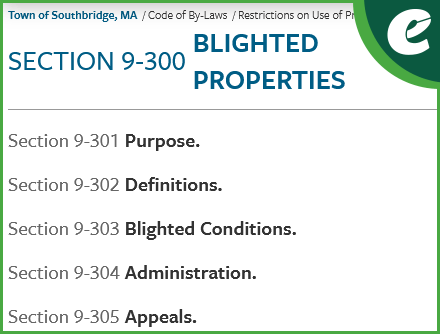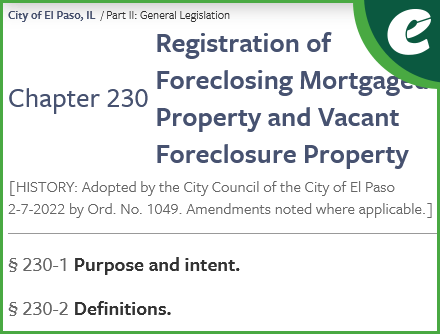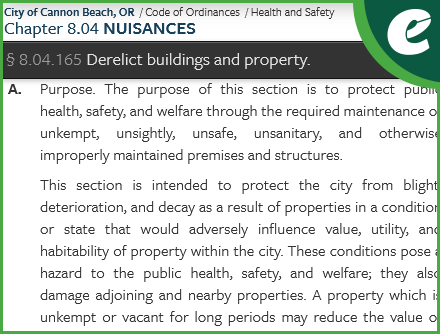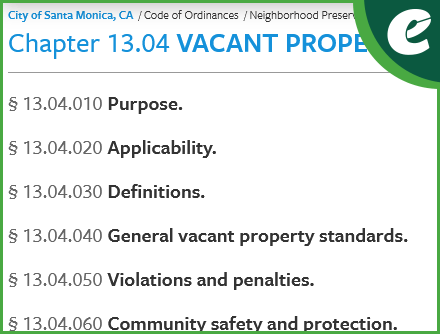Blighted properties are an ongoing challenge for most communities in the United States. And with the current affordable housing crisis, the topic is a rising concern for local governments. Many are examining their municipal codes to ensure blighted property legislation is enforceable and able to address the current conditions.
View sample blighted property legislation >
Defining blight
Blight can actually be a two-fold issue in some places. Generally, most agree that a blighted property refers to its physical condition and appearance. But some localities also consider blighted properties to be those that are subject to unpaid taxes.
Blight can include structurally unsafe conditions, being a visual “eyesore,” and unkept landscaping (overgrown lawns, uncontrolled weeds, dangerous conditions of trees, etc.). Blighted properties might be inhabited, abandoned or foreclosed, and even vacant lots.
For local governments, it’s important to be clear in defining blight and the specific conditions that identify a property as such.
Everyone’s problem
Blight is not just a problem for the owners of a property or the inhabitants; its impact reaches beyond its property line to the immediate neighbors and the community as a whole — creating physical and emotional strains, and putting individuals at risk for crime and other acts of violence.
As noted by the Center for Community Progress:
- Individuals living in substandard housing can be exposed to dangerous toxins such as mold, lead, and asbestos, increasing the risk for asthma, cardiovascular disease, increased aggression, learning disabilities, sexually transmitted diseases, and poor health outcomes.
- Visual evidence of vacancy and neighborhood disinvestment — such as boarded up properties, trash and dumping, and overgrown weeds—has been shown to harm the mental health of neighbors, putting them at greater risk of sadness, depression, stress, and elevated rates of intentional injury.
- Studies have shown that violent crime, including assaults and gun-related crimes, increase in disinvested neighborhoods with vacant and abandoned properties.
- Research has consistently shown that vacant, abandoned, and deteriorated properties reduce the value of surrounding properties, leading to decreases in owners’ equity and personal wealth.
- Homeowners within close proximity to abandoned properties are often charged higher insurance premiums or even face policy cancellations because of the unstable nature of the neighborhood created by the vacant properties leaving homeowners with greater financial liabilities.
The cost to the municipality as a whole is just as steep, but in different ways. The Center goes on to suggest that local governments suffer these additional harms:
- Property taxes are typically the largest source of revenue for local governments. Research has shown vacant and abandoned properties lead to a decrease in taxable values of surrounding properties and increase the likelihood of mortgage and tax foreclosures nearby creating a harmful domino effect that creates revenue challenges for local governments.
- Local governments incur the costs of remedying nuisances and unsafe conditions, including boarding and securing structures, cutting grass, removing trash and debris, and demolishing unsafe structures.
- Higher violent and property crime rates and the associated costs to dispatch police and fire services to respond to these crimes are commonly associated with vacant and abandoned properties.
Taking action
Local governments can address their blight challenges from a few angles: prevention, abatement, and enforcement. Properly legislating is key to the success of the chosen approach.
One remedy that is increasingly being employed by municipalities is developing a “Vacant Property Registration” ordinance. It requires owners of vacant properties to register with their local government. The registry becomes a reference tool when problems arise at the vacant properties. It saves staff time from having to track down the responsible parties. Most vacant property registries require a fee to register with the municipality and include penalties for not registering to encourage voluntarily participation.
With statistics that suggest an abandoned property in an area will pull down the value of surrounding properties by anywhere from 0.4 to 3.5%, removing blight from a community can help to stave off the threat of negative equity and foreclosures. In some cases, localities will take on the demolition of blighted properties and restoring the lots to developable condition, thereby facilitating the ability to turn the vacant properties into affordable housing, stores, or other revenue producing assets.
Additionally, programs that allow owners of blighted properties to work with the municipality to cost-effectively repair or abate the problems with their homes or lots is something that a few local governments are experimenting with.
Useful examples of blighted property legislation from the eCode360® Library
If your community is interested in enacting blighted property legislation, here are some useful examples that can be found in our eCode360 Library:
Updating your municipal code is vitally important
Did you know you can set up a regular update schedule, so you don’t have to worry about compiling materials or taking up time and resources of your staff to do the updates yourself? As your municipality passes legislation, send it to General Code and we’ll take care of the rest. It’s just that simple!
For tips that will allow us to process your code updates most efficiently, click here.
Questions about updating your code?
Our Client Care team is available to explain the options and benefits of scheduled code updates or any other code-related questions you might have.
Sources:
- The Problem with Calling Neighborhoods with Vacant Properties “Blighted”
- How Vacant and Abandoned Buildings Affect the Community
- New Data on Local Vacant Property Registration Ordinances
- Fighting blight: how cities across Virginia are addressing abandoned property
- ‘Raze & Revive’ program turns Milwaukee’s blighted properties to affordable homes
- Blighted Property Law
- Urban Blight and Public Health
- Comparison of municipal blight ordinances (OLR Report – Connecticut)
- eCode360 Library of municipal codes






